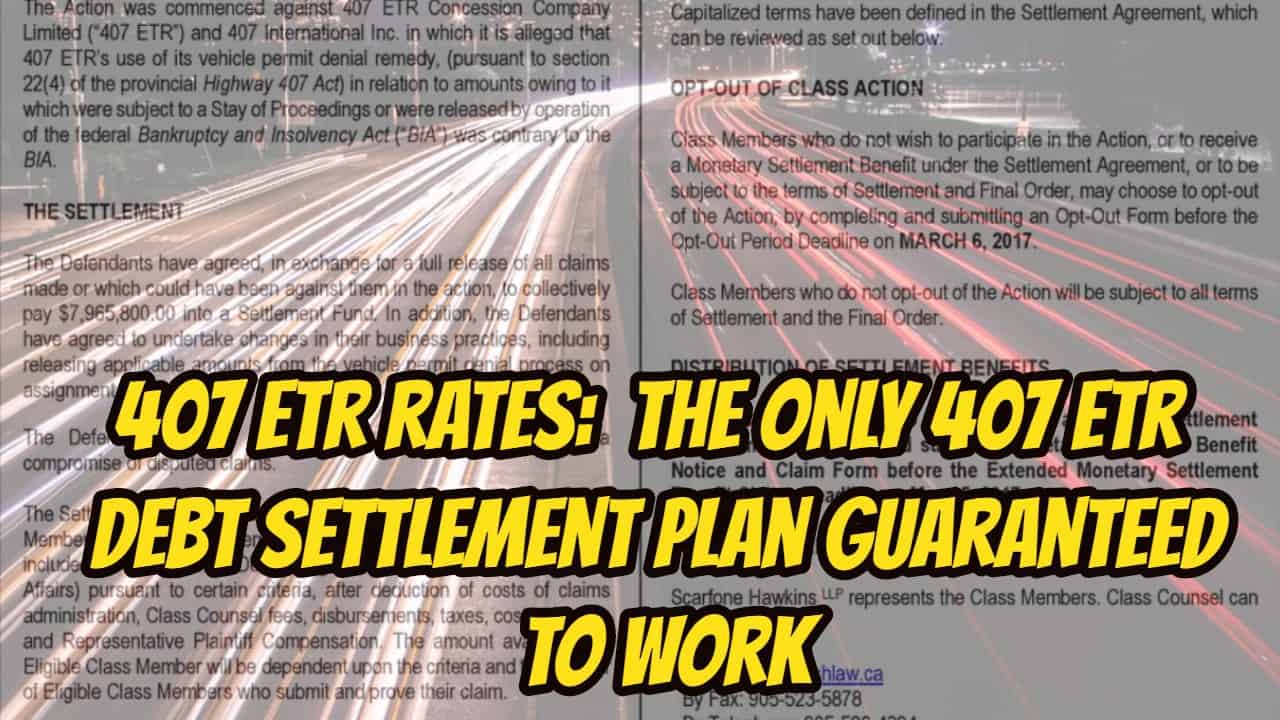We are trying something new. At the bottom is an audiogram of this 407 etr rates Brandon’s blog. If you would prefer to listen to it, and not read it, scroll down to the bottom and press on the play button. Let us know what you think by sending us a message in the Question box below.
407 etr rates: Introduction
The purpose of this 407 etr rates is not to tell you what the new toll rates are. The simple answer is that they are always going up! Rather, it is an update to our earlier blogs for people who are having trouble paying their 407 toll payment.
As you probably know, the 407 etr has an arrangement with the Province of Ontario where if you have unpaid 407 etr charges, you will be put on plate denial the next time you have to renew your vehicle plate. For many, being denied a plate renewal means the end of your ability to earn an income.
Before the update, a bit of history to put everything into perspective for you.
407 etr rates: Our prior blogs
We previously wrote about how the 407 etr was trying to use the provincial law as a collection tool, even when a person filed for a debt settlement restructuring consumer proposal or for personal bankruptcy. Our prior blogs were:
- 407 ETR DEBT SETTLEMENT: OUR NEWEST GUILT FREE WAY TO DO IT
Posted on November 19, 2015 - 407ETR BANKRUPTCY DEBT CHECKLIST: YOU NEED IT NOW!
Posted on November 25, 2015
I won’t repeat the history here as you can check those blogs yourself. Suffice to say they argued in Court, unsuccessfully, that the Province had the right to enforce its own plate issuance rules.
The lower Court and the Court of Appeal for Ontario disagreed with their right to enforce the plate issuance rules when it was a blatant action to collect an ordinary unsecured debt caught in the priority scheme of the Bankruptcy and Insolvency Act (R.S.C., 1985, c. B-3) (BIA). The Courts also found that they were trying to trump Federal law through Provincial law, which is illegal. Finally, the Supreme Court of Canada refused to hear their appeal, so that is where it ended, sort of.
407 etr rates: So that is where it ended, sort of
With those rulings, the 407 etr stated that they would comply and drafted a policy which was an extremely literal wording of the BIA. It technically complied with the Court rulings, but still had the effect of being very draconian and not changing their administrative policy.
The debts of an insolvent person, who has made a debt restructuring consumer proposal or bankruptcy filing, are not discharged until the insolvency process is complete. For a debt settlement plan, it is when the person finishes making their payments and receives their Certificate of Full Performance. In a bankruptcy, it is when they receive their absolute discharge.
How those processes work deserves their own blogs. Suffice to say the processes can take anywhere from a minimum of 9 months (first-time bankruptcy, no surplus income, no assets and no discharge opposition) up to 5 years (debt settlement plan). So the plate denial actually stayed in force for a long time.
The 407 etr also set up a very document intensive 407 etr login process that made applying for the eventual rescission of the plate denial very cumbersome.
407 etr rates: The class action lawsuit
The firm that independently runs Highway 407 ETR in the Greater Toronto Area agreed to pay $8 million to clear up this claim. The settlement, approved in November 2016, finishes the litigation that began in 2012.
The lawsuit affirmed that the toll freeway consortium unlawfully used provincial regulations to stop motorists that were insolvent or bankrupt from restoring their automobile permit plates. 407 ETR refutes it did anything incorrect and does not confess obligation in approving the out of court negotiation.
407 etr rates: Now for the update – The only 407 etr debt settlement plan guaranteed to actually work
The licensed insolvency administrator (LIT) acting as either the bankruptcy Trustee or consumer proposal Administrator, acting as either the bankruptcy Trustee or consumer proposal Administrator, will issue the Notice of Bankruptcy or Consumer Proposal. 407 ETR must be listed on your sworn Statement of Affairs as a creditor. It will then be sent a copy of the notice by the LIT.
Upon receipt, 407 ETR will end from plate rejection any amounts still owing from before the date of filing either for bankruptcy or a consumer proposal. This includes toll charges, interest, penalties and costs. They will then advise the Ministry of Transportation to upgrade their documents to show this change ending plate denial. This is a major change. You do not have to have completed your full insolvency process to get the lifting of the plate denial. This is the way fairness dictates it always should have been from the start.
There is a simple rule that you have to follow. It is the same rule that you need to follow in dealing with any leases or secured debt that you wish to continue to carry and that you can afford to. That is, you must not have any amounts owing to 407 etr for charges after your filing date which would qualify for plate denial.
407 etr rates: Are you worried about or need relief from plate denial
- Are you under plate denial, or afraid you will be soon?
- Will plate denial negatively affect your income and you need debt relief fast?
- Do you have other debts that need to be addressed too?
- Do you need budgeting help?
- Are you already experiencing financial difficulties?
If you answered yes to just one of these questions, you need a professional trustee. If yes, call the Ira Smith Team. Our approach for each file is to create an end result where Starting Over, Starting Now takes place. This starts the minute you are at our front door.
We always offer a free consultation. We listen to your issues and give you a full range of realistic options to help you get out of debt. Finding the best solution for YOU is just the right thing to do to help you meet total debt freedom.
The earlier you contact us, the more options we will have to carry out. Whether it is a corporate restructuring or personal debt settlement through a consumer proposal, the goal is to avoid bankruptcy. However, if bankruptcy turns out to be the best option, we can assist there too.
You’re simply one phone call away from taking the necessary steps to get back to leading a healthy, balanced hassle-free life, ending the pain and stress you are feeling forever. Call Ira Smith Trustee & Receiver Inc. today for your free consultation.


